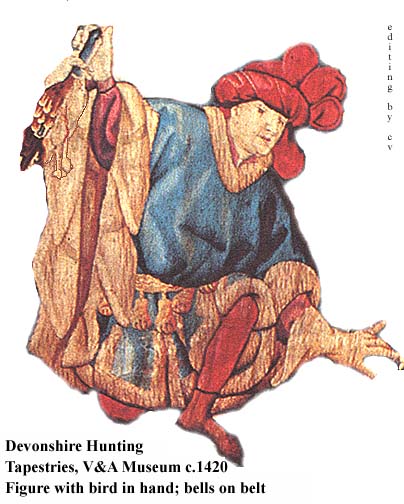However, it's a good time to consider adding bells to your 14th-through-15th century outfits, because they're in the stores all over.
 Note
the bells on the belt of the squire, and the decorated hose!
Note
the bells on the belt of the squire, and the decorated hose!On Lijsbeth, you can see the equitorial seam on the bells. Also: it's hard to see at this size, but her houppelande is tied at several points down the front opening!
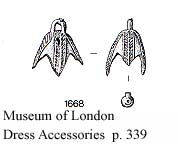
- "Clapper" or "open bell" sort, which is open at one end and has a weighted bit in the center that swings against the edge to make the sound,
- "Rumble(r) bell" which most of us would call a "jingle bell" -- a closed shape of metal with a "pea" that moves around randomly inside to make the noise.
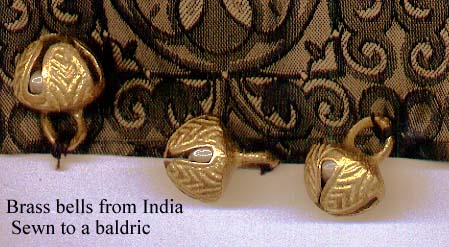
Many people believe that the ornate strings of gold-colored thingies depending from gold collars on the young people in the Tres Riches Heures paintings may have been gold bells.

"The bethrothal portrait of Lysbeth van Duvenvoorde, painted c. 1430, shows her wearing a high-waisted girdle to which rumber bells were fitted by means of plied, bi-colored cords so that they jangled on her hips." See above for a small version. Link to very large image at the Rijksmuseum in Amsterdam.
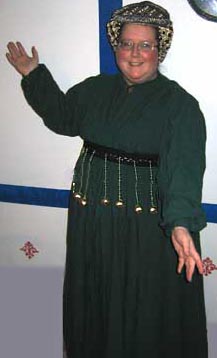 Here is a picture of my in my
first version of such a belt, over my green wool houppelande. I
used bells from a bell-wreath of
the sort sold at Christmas, bought at Marshall's/TJ Maxx type store for
$12, it gave me about 25 bells in bright-and-shiny, and 25 in matte
gold. These are the matte gold ones. It wasn't nearly as
noisy as I expected, unless I was dancing.
Here is a picture of my in my
first version of such a belt, over my green wool houppelande. I
used bells from a bell-wreath of
the sort sold at Christmas, bought at Marshall's/TJ Maxx type store for
$12, it gave me about 25 bells in bright-and-shiny, and 25 in matte
gold. These are the matte gold ones. It wasn't nearly as
noisy as I expected, unless I was dancing.
The cords are a commercial
plied cord of gold and medium green, laced through the decoration on
the belt, which I've had for a long time.
Although the very shiny modern jingle bell may have been the desired end-product for the medievals, my opinion is that the shininess will make it appear too modern when wearing it with garb, and I find the Indian bells to have a sweeter tone.
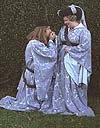
Here's a picture of my husband and myself wearing our bell-baldrics. (click for larger)

